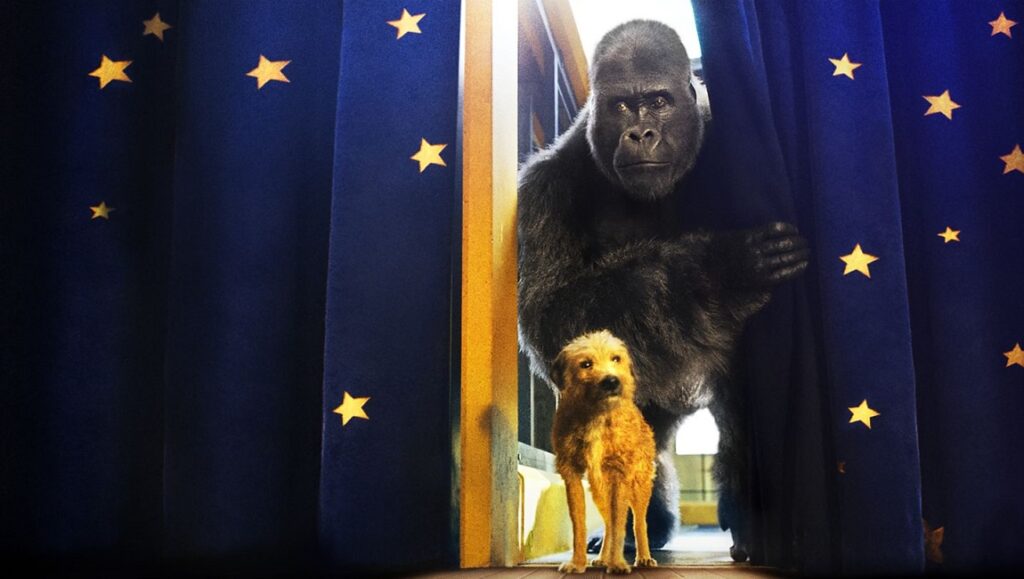The One and Only Ivan is an intentionally inclusive, surprisingly unbusy animated offering from Disney.
Over the past few weeks, Disney has gone on a bit of a promotional blitz for their latest animal-centric feature, The One and Only Ivan, with ads built around a cacophony of bright colors, gorilla screams, and thick slabs of Bryan Cranston ham. It seems safe to assume that parents harbored conflicted feelings about its eventual release, steeling themselves to endure the shrill antics promised in the marketing for the chance to soothe restless kids stuck in a pandemic haze. It’s a bit of shock, then, that The One and Only Ivan is a different beast all together, a surprisingly sweet and gentle film that favors contemplative discussions of freedom and identity rather than indulging in overwrought busyness. It is also, welcomingly, the gayest film Disney has ever produced. Parsing out intent remains a challenge for a while, leaving audiences to wonder if these impeccably animated CGI animals are the building blocks in some inclusive, stealth allegory or just superficially cute Disney creations.
The early going doesn’t do much to disarticulate the two reads: Dame Helen Mirren pops up as a haughty but loveable poodle while Chaka Khan voices a sassy hen who is also a den mother to the stable of animals, and though both women are arguably gay icons in their own right, there’s little beyond loose signals to suggest this somewhat radical read is anything more than Disney’s typically indistinct template opening itself up to wishful thinking and projection. But then Ivan (the gorilla) starts lamenting the fact that he only acts tough — read: classically, heteronormatively masculine — because of societal expectations, and it seems the Mouse House isn’t hedging so much after all. Obviously, that’s not to say that straight men should subscribe to such reductive notions of manhood, but given that the film was written by Mike White, a screenwriter who has brought a gay sensibility to most of his works, from Chuck and Buck to Year of the Dog to School of Rock, it seems the choices made were in fact savvy calculations intent on opening the film up to such a reading at the very least.
In broad strokes, The One and Only Ivan is the story of a group of trained animals held captive in a small-town mall who long for freedom. But in the details, the film is a tribute to those individuals stuck in the prison of social constructs, whose identities are reduced to culturally digestible stereotypes and limitations. Ivan not only wants to feel the breeze on his face and the grass under his feet, but to be accepted for who he truly is, a gentle giant who would rather create art than act like a macho beast. Okay, so maybe the film isn’t entirely subtle or even very complex. There is considerable discussion among the animals dedicated to how truly awful humans are, with Danny DeVito’s lovable mutt describing them simply as “cockroaches” — and honestly, the past couple years have done little to disabuse this conclusion. As the lone voice of hope, wise and soft-spoken mother elephant Stella (Angelina Jolie, for some reason) repeatedly states that humans have the ability to surprise, sometimes in the most unexpected and heartfelt ways. Is humanity still capable of goodness? It’s heady stuff from a film that also features a farting dog, but the message of tolerance and challenge to be better is something that we, and especially children, should welcome now more than ever.
Director Thea Sharrock, herself no stranger to unconventional tales of individuals longing for freedom (Me Before You), seems far more interested in the film’s quiet moments — a dog nudging its owner’s arm to allow for a more comfy sitting space, a shared, nonverbal moment of purity between man and beast — than its handful of big set pieces. Sure, there is some unnecessary digression here and there, adapted as it is from a 78-page, illustrated children’s book, but it’s moments of gentleness and compassion sing. That this is a based on a true story is rather heartbreaking, as is the fact that the film’s happy ending involves trading one form of captivity for another, and it will hopefully inspire conversations between parents and kids that will ensure a better future for the next generation of the world’s wildlife (in addition to the other obvious dialogues The One and Only Ivan seeks to spawn). Meanwhile, in the end, Ivan gets to be exactly who he wants, society cheering him and embracing the very qualities that make him different. We should all be so lucky.


Comments are closed.